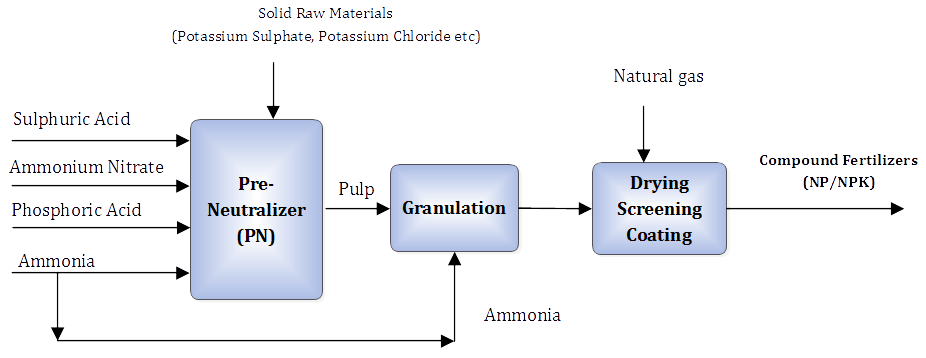Complex fertilizers units (NPK UNITS)
The production of complex fertilizers (NPK’s) is taking place in three (3) independent units enabling PFIC to produce 3 different formulas simultaneously. Two of the NPK units are identical units (U-1500 line A and line B) which were started up in 1965 and revamped in 1982. Additionally, many modifications/improvements were applied over the last 20 years. The capacity of each unit depends on the formula produced and ranges from 400 to 600 MT/day. The third NPK unit (U-900) was started up in 1982 and its capacity ranges from 500 to700 MT/day.
All the units are using the so called “slurry process” for the production of NPK’s. Gaseous ammonia reacts with phosphoric and sulphuric acid in a special vessel (preneutralizer). The operating conditions are regulated in such a way that the phosphoric acid is partially neutralized by ammonia. The produced slurry is introduced in a rotating drum (granulator) where it is mixed with solid recycle. Further ammoniation is taking place in the granulator by liquid ammonia. The produced granules are dried in a dryer and sieved. The coarse material is crushed, mixed with fines and returns to the granulator. The commercial product is cooled, treated with anticaking agent and sent to storage. Depending on the formula produced, additional raw materials can be added like:
- AN – solution
- Potassium sulphate (SOP)
- Potassium chloride (MOP)
- Solid Ammonium Sulphate (AS)
- Various sources of secondary nutrients and micronutrients
- Inerts etc.
Theoretically there is an immense number of NPK formulas which can be produced. Apart from the classical formulas produced in 1965 (16-20-0, 11-15-15 SOP) PFIC produces now a large number of new products including special types in response to the demand of the domestic and the international market. High nitrogen NPK’s, special formulas with secondary nutrients and micronutrients are common practice the last years.
